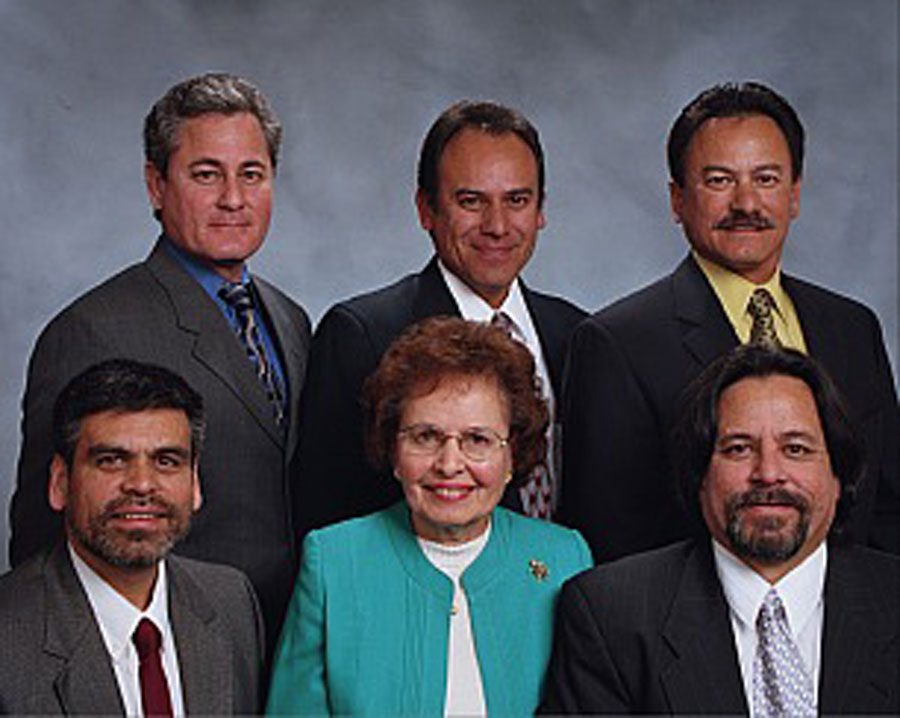
COLLEGE STATION, TX – David Aguirre jumped in his truck and drove toward the hospital in the predawn darkness the minute he got the news: His 91-year-old mom was being rushed from her Texas assisted living facility to the emergency room.
Estela Aguirre would be one of five residents to die and six others to be sickened by the novel coronavirus at The Waterford at College Station, part of a financially strapped chain of assisted living sites called Capital Senior Living.
“My mom was a sweet, kind person. People really felt like they’d known her for 100 years. She was just that kind of soul,” said Aguirre, who lost his mother on March 28. “Some days, I’ll sit down and have my heart cry.”
Assisted living complexes, home to more than 800,000 people nationwide, have quickly become a new and dangerous theater in the coronavirus war. Challenged by deepening financial pressures, sicker residents, limited oversight and too few employees, they now face a crisis that could force companies into bankruptcy, roil the industry and even close some facilities — putting frail seniors at greater-than-ever risk.
More than 700 cases of COVID-19 at assisted living facilities had been reported in at least 29 states as of Wednesday, according to public health authorities and news organizations.
Capital Senior Living serves as a prime case study of the new dangers facing the assisted living industry and the people they serve. The Dallas-based company, which owns or operates more than 120 senior communities nationally, told investors on a March 31 conference call that residents at three of its facilities had tested positive for the coronavirus.
Even before those cases struck, though, the company was ailing. Its stock had plummeted 80% since late February. Last week, the company disclosed a 2019 loss of $36 million. Officials said on the conference call they had sold complexes in recent months, even before the surge of COVID-19 cases, to improve the firm’s financial cushion. Recently renegotiated leases will also help, they said.
The pandemic looks poised to exacerbate its finances further, as residents lose their ability to pay amid the faltering economy and costs rise to care for them.
And fragile economics compound the threat of the virus that rages through assisted living facilities, which are much less regulated and medically equipped than nursing homes but serve tens of thousands of America’s most vulnerable elders.
Problems Magnified
When Georgia officials inspected Capital Senior Living’s Waterford at Oakwood facility in February, their report said it “failed to provide watchful oversight consistent with the residents’ needs.”
Employees and residents told inspectors more staff was needed, and a review of the call log showed it sometimes took more than half an hour for workers to respond to residents, according to the inspection report.
Company officials said in a written statement that they can’t comment on individual cases but that “our top priority is always the safety of our residents and employees.”
The company lists at least 650 job openings on its website, many for credentialed positions such as certified nursing assistant or certified medical assistant. But a Facebook post on an Iowa facility’s website says: “If you are interested in a nursing aid position, you do NOT have to be a CNA and will be trained on site.”
With 6,300 employees, the company said, it “always has several hundred job openings.” As employees are furloughed in other industries, it said, it “has accelerated its activities to seek top talent.”
Staffing levels have grown in importance — and become harder to adequately address — in assisted living facilities as people increasingly “age in place” and try to avoid expensive nursing homes.
“In many ways, today’s assisted living residents are yesterday’s nursing home residents,” said Robyn Grant, director of public policy and advocacy at the National Consumer Voice for Quality Long-Term Care. “You have a perfect storm, with the needs increasing while [regulatory] requirements have not kept up with that.”
Grant said virtually no federal standards for assisted living exist, as they do for nursing homes. “We have a patchwork of regulation. In some states, you have more robust protections. In some, they are weak and inadequate. For residents, it is the luck of geography.”
As the pandemic grows, advocates for seniors worry that conditions will worsen as employees stop coming to work because they fear COVID-19 or must stay with children whose schools have closed. Or they may contract the coronavirus themselves.
“We’re really concerned about this when residents need more staff than ever,” said Tony Chicotel, an attorney with California Advocates for Nursing Home Reform. “We’re gonna have the opposite.”
There are more than 25,000 assisted living facilities across the country, and the median monthly cost to live in one is $4,000, according to the National Center for Assisted Living. Residents, more than half 85 or older and often with arthritis, memory problems and depression, need help with daily tasks but receive less medical attention than in a nursing home. That’s because assisted living staffs are typically smaller and the workers have less health care training than those at nursing homes. And fewer than half the states have minimum staffing regulations for assisted living communities.
Sheryl Zimmerman, a professor in the School of Social Work at the University of North Carolina at Chapel Hill, said only about half have a nurse on staff, and many workers are personal care aides, not certified nursing assistants. Staffers don’t receive as much training about things like the use of gloves and masks as do nursing home workers, even though they often help residents with eating, bathing or using the toilet.
“It’s not a health care workforce,” she said. “In general, they do not have the level of infection prevention you would hope to see.”
Staff shortages exacerbate this issue, and the surging economy and low unemployment before the pandemic meant many senior communities were already struggling to hire employees, said Amy Orlando, a Connecticut attorney specializing in elder law.
Rising wages to attract or retain workers and fierce competition fueled by a building boom a few years ago led to financial challenges at many assisted living facilities, said Beth Burnham Mace, chief economist for the National Investment Center for Seniors Housing & Care, a nonprofit research organization.
Financial Straits
Capital Senior Living is among the companies under extreme pressure.
As the company’s stock price has fallen to a few dimes, investors fear a possible bankruptcy filing, financial analysts said in interviews. They are worried new residents will stop moving in as others leave or die, hurting revenue. More than half its communities are below 90% occupancy, according to an executive on the conference call. Analysts say that level is roughly the minimum needed for profitability.
“I have confidence in our ability to continue delivering great service and a warm, caring environment to our residents,” Brandon Ribar, the company’s chief operating officer, told stock analysts on the call.
The company declined to make executives available to KHN for an interview but said it is “exercising extreme caution” and “following strict disinfecting and sanitizing guidelines.” Among the safeguards are screening anybody entering a facility and quarantining new residents for their first 14 days.
But one analyst raised a dire scenario if the pandemic worsens: the theoretical closure of facilities.
“Is there a certain rule of thumb, where if occupancy hits a certain point you just say, ‘Hey, let’s just shut down this facility, because we’re just going to lose too much money?’” Steven Valiquette, of Barclays Capital, asked executives on the conference call.
CEO Kimberly Lody, who was brought into the company last year, dismissed the concern, saying Capital Senior Living has “strong flexibility” to reduce staff and other costs if the number of residents decreases substantially at particular facilities.
Assessing The Quality Of Care
Several relatives of the facilities’ residents said they put their trust in staff members because they’ve generally been happy with their loved ones’ care.
Barry Curtis, whose 85-year-old mother, Orvaline, lives at the company’s Sugar Grove facility in Plainfield, Indiana, said he knows staffing can be a problem for communities but hasn’t seen much turnover at Sugar Grove or heard complaints about staffing from his mom. But the pandemic has revived old, haunting memories of her father telling her about pulling carts down Arkansas streets to pick up bodies during the 1918 flu.
Debbie Gilbert, whose brother Donald Bussey lives in assisted living at River Crossing in Charlestown, Indiana, said staffing has also been “pretty consistent” at the site. “They’re doing the best they can out there,” she said.
Assessing the quality of care is difficult. There’s no assisted living resource comparable to Nursing Home Compare, a federal website that includes star ratings, staffing levels and inspection results for nursing homes.
A KHN review of online inspection records in nine of the 23 states in which Capital Senior Living operates found dozens of problems in the past five years, including instances of insufficient staff, inadequate infection control and failure to screen employees for criminal violations. However, it is difficult to compare the overall quality of the company’s facilities to those of other companies within most states or around the country.
But within California, records show the company’s Garden Court at Villa Santa Barbara had 16 substantiated allegations since mid-2016, more than four times the average number among licensed facilities with at least one.
For example, inspectors last year found the facility contracted with an outside agency that could show no proof it was certified to provide home services to residents. Inspectors also found that staff members contracted to provide care had no records of training or licensing as skilled professionals such as registered nurses or licensed vocational nurses. The facility pledged to ensure staffers have basic training and that outside agencies have credentials before starting work.
The company added it has a “rigorous Quality Assurance program” and has instituted new leadership across the company that has “positively impacted operations and resident care.”
COVID-19 threatens to erode oversight and transparency even more. Long-term care ombudsmen, who traditionally went to facilities and talked to residents, now must assess care from afar because of restrictions on visitation. And COVID-19 has removed another type of helping hands and watchful eyes.
“We know when family and friends are visiting, they’re monitoring, seeing the condition of their loved ones,” Grant said. “They are now without those additional ears and those additional eyes.”
And there’s always a foreboding, a sense the virus could find its way into the facility — as it did in Texas.

Aguirre said his mom was in relatively good health for her age. She had memory problems, congestive heart failure and Parkinson’s disease, but her symptoms were mild.
Aguirre said his family was pleased with the care she got at the Waterford. The Brazos County Health Department said the facility had taken steps to prevent the spread of COVID-19 by restricting visitors, screening staff and using “enhanced cleaning procedures.”
“I still hold very high praise for the staff in the facility,” Aguirre said. “They’re doing all they can with everything they’ve got.”
By the time a hospital doctor broke the news to Aguirre of his mother’s positive COVID-19 test, there was no way to save her because her lungs were so badly damaged.
The doctor offered him the chance to say goodbye if he wore protective equipment.
But Aguirre, 67, said he feared being sickened by the virus or spreading it to his family.
So he missed seeing her draw her last breath.
Jay Hancock from Kaiser Health News contributed to this report which also appeared in USA Today. It was published in cooperation with Kaiser Health News Network and The Published Reporter.



Comments are closed.